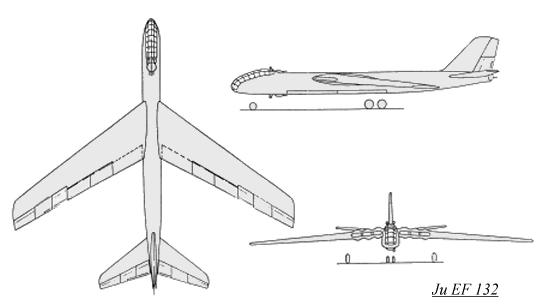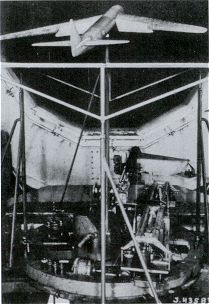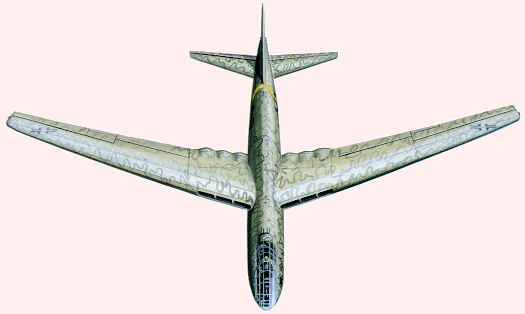 The Junkers EF 132 was one of the last aircraft project developments undertaken
by Junkers in WWII, and was the culmination of the Ju 287 design started
in 1942. The shoulder-mounted wings were swept back at a 35 degree angle
and featured a small amount of anhedral. Six Jumo 012 jet engines, each
of which developed 2500 kp (5500 lbs) of thrust, were buried in the wing
roots. Wind tunnel results showed the advantages of having the engines
within the wing, rather than causing drag by being mounted below the wing
surfaces. Several wooden mockups were built of the wing sections, in order
to find the best way to mount the engines without wasting too much space
while at the same time providing maintenance accessibility. The landing
flaps were designed to be split flaps, and the goal was to make the gearing
and operation simple. Because of the high placement of the wings to the
fuselage, an unbroken bomb bay of 12 meters (39' 4") could be utilized
in the center fuselage. The tail planes were also swept back and
the EF 132 had a normal vertical fin and rudder. An interesting landing
gear arrangement was planned, that consisted of a nose wheel, two tandem
main wheels beneath the center rear fuselage, and outrigger-type wheels
under each outer wing. A fully glazed, pressurized cockpit located in the
extreme fuselage nose held a crew of five. Armament consisted of two twin
20mm cannon turrets (one located aft of the cockpit, the other beneath
the fuselage) and a tail turret containing another twin 20mm cannon. All
of this defensive armament were remotely controlled from the cockpit, and
a bomb load of 4000-5000 kg (8818-11023 lbs) was envisioned to be carried.
The Junkers EF 132 was one of the last aircraft project developments undertaken
by Junkers in WWII, and was the culmination of the Ju 287 design started
in 1942. The shoulder-mounted wings were swept back at a 35 degree angle
and featured a small amount of anhedral. Six Jumo 012 jet engines, each
of which developed 2500 kp (5500 lbs) of thrust, were buried in the wing
roots. Wind tunnel results showed the advantages of having the engines
within the wing, rather than causing drag by being mounted below the wing
surfaces. Several wooden mockups were built of the wing sections, in order
to find the best way to mount the engines without wasting too much space
while at the same time providing maintenance accessibility. The landing
flaps were designed to be split flaps, and the goal was to make the gearing
and operation simple. Because of the high placement of the wings to the
fuselage, an unbroken bomb bay of 12 meters (39' 4") could be utilized
in the center fuselage. The tail planes were also swept back and
the EF 132 had a normal vertical fin and rudder. An interesting landing
gear arrangement was planned, that consisted of a nose wheel, two tandem
main wheels beneath the center rear fuselage, and outrigger-type wheels
under each outer wing. A fully glazed, pressurized cockpit located in the
extreme fuselage nose held a crew of five. Armament consisted of two twin
20mm cannon turrets (one located aft of the cockpit, the other beneath
the fuselage) and a tail turret containing another twin 20mm cannon. All
of this defensive armament were remotely controlled from the cockpit, and
a bomb load of 4000-5000 kg (8818-11023 lbs) was envisioned to be carried.
![]() View Marek Rys' Ju EF132 images
View Marek Rys' Ju EF132 images
| Span | Length | Height | Wing Area | Aspect Ratio | Wing Loading | Thrust/Weight Ratio |
| 32.4 m
106' 4" |
30.8 m
101' 1" |
8.4 m
27' 7" |
161 m²
1733 ft² |
6.5 | 403.7 kg/m²
32.65 lbs/ft² |
4.33 |
| Empty Weight | Fuel | Lubricants | Crew | Load | Max. Permissible Load | Takeoff Weight |
| 31300 kg
69004 lbs |
18000 kg
39683 lbs |
250 kg
551 lbs |
500 kg
1102 lbs |
14950 kg
32959 lbs |
33700 kg
74295 lbs |
65000 kg
143299 lbs |
| Max.
Speed |
Cruising
Speed |
Rate of
Climb |
Service*
Ceiling |
Max.**
Range |
Max. Flight
Time |
Takeoff
Run |
Landing
Run |
Landing
Speed |
| 930 km/h
578 MPH |
850 km/h
528 MPH |
15.5 m/sec
51 ft/sec |
10300 m
33792' |
3500 km
2175 miles |
2.7 hours | 1260 m
4134' |
580 m
1903' |
190 km/h
118 MPH |
**The Maximum Range in another source is shown to be 9800 km (6090 miles), which again seems more likely given the Ju EF 132 was designed as a long range bomber
| Junkers Ju EF132 Models |
| There are no models of the Junkers Ju EF132 available at the present time |
The Ju EF 132 windtunnel model being tested
at the Junkers Dessau facility - 1945
 |

Above image from Geheimprojekte der Luftwaffe Band II: Strategische Bomber 1935-1945 |